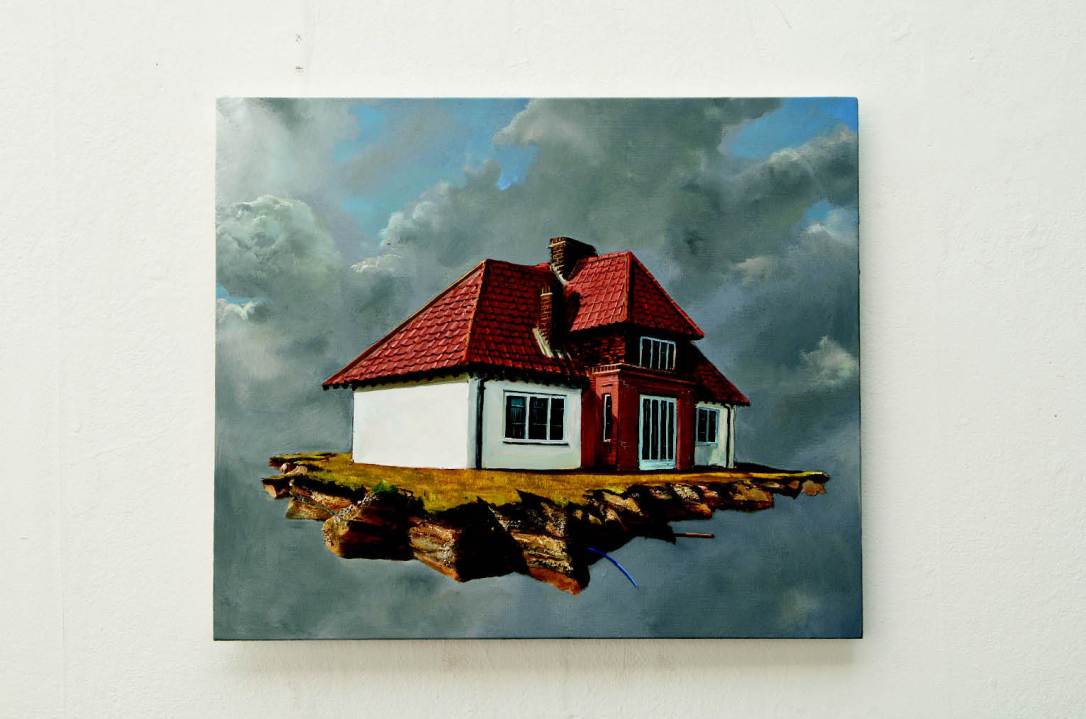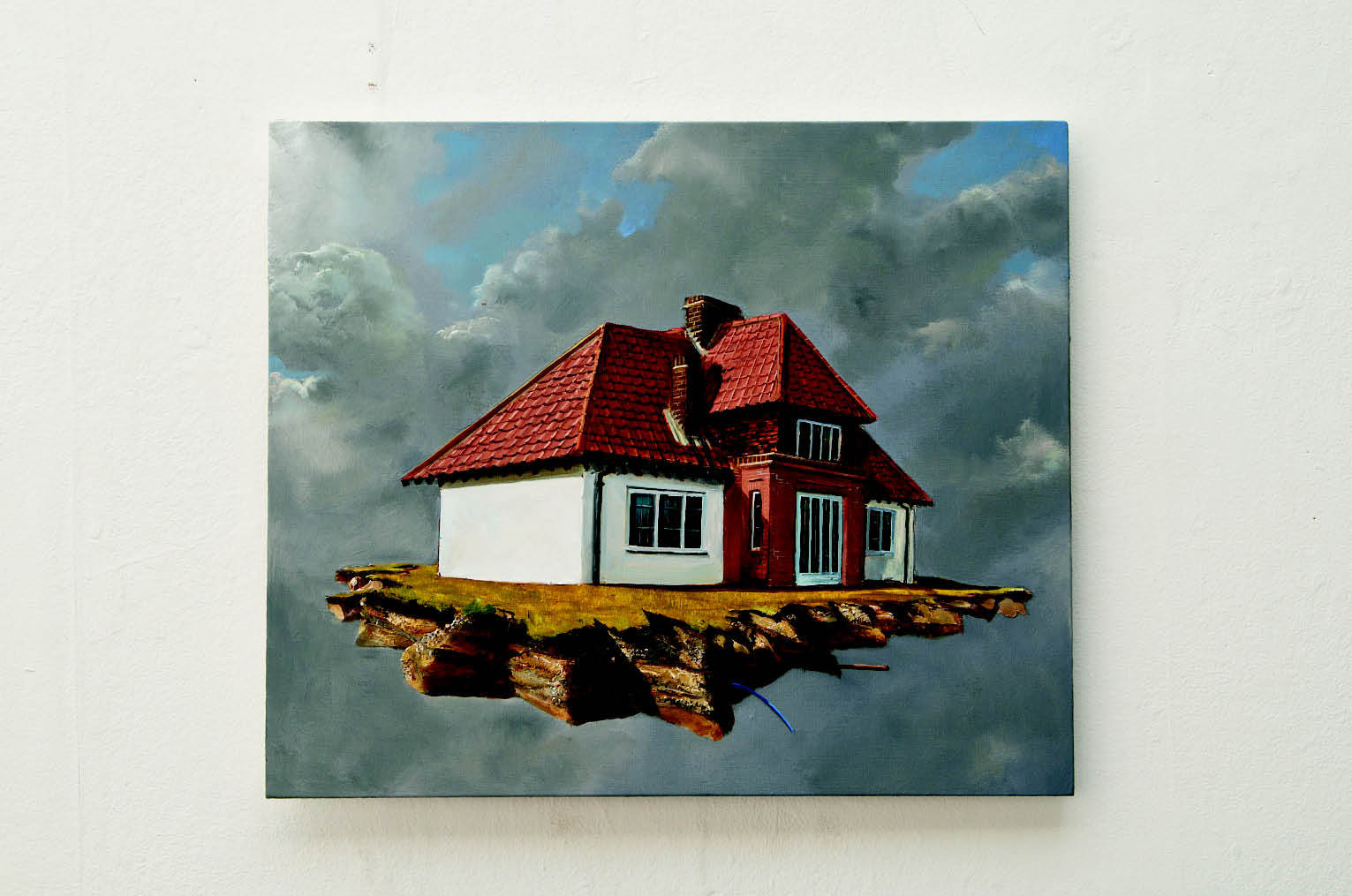Julian Perry (born 1960) paints images of genuine topicality in an immaculate high-definition realist style.
Julian Perry (born 1960) paints images of genuine topicality in an immaculate high-definition realist style. His last show in 2007 dealt with the allotment sheds bulldozed by the relentless encroachment of the Olympic site. Since then he has been painting pictures of coastal erosion, visiting locations around England and composing hallucinatory images of deracination and loss.
‘Clifftop with Fridge Freezers’ was one of the first of the new series. I asked him to describe the subject. ‘It depicts a dairy that has fallen victim to what I think is called “rotational slump”, when alluvial till, or glacial till, which is basically mud, slides away down a cliff at 45 degrees and just rips any buildings on top of it apart,’ says Perry cheerfully. ‘We’re looking at the roof trusses of a barn and the abandoned fridge freezers halfway down the side of a cliff. It’s a bit like a battlefield. I thought that I was going to explore the destructive aspect of coastal erosion and that the images were going to have this post-Apocalyptic quality, whereas ultimately what I’ve done is try to create images that are paradoxically about preserving the subjects in the painting.
‘When you arrive at a site of coastal erosion, nine times out of ten it’s been completely tidied up. There’s very little to see.’ Isn’t it then perverse to make paintings of the subject? ‘I rather modestly think that I came up with an angle on it that creates a very strong visual response by mixing up the time periods of before and after. When you arrive at these places there might not be a lot to see – a bit of debris at the bottom of a cliff – but what everyone thinks is “a bungalow used to be in that space.”’ So that’s what Perry paints: the bungalow on its raft of soil, floating gently in midair.
A passing visitor who knew nothing of the subject of Perry’s new work but wandered into the gallery to see his paintings might be puzzled by these levitating houses and ‘flying carpet’ images. I asked him if he found this lack of obviousness disturbing. ‘No, I think it’s good. What most pictures actually need is the ability to gain people’s interest. We live in such an extraordinary visual world that if a painting provokes people to wonder what they’re looking at, you’re off to quite a good start. If people then are inspired to investigate further, so much the better.’
Why did he choose this subject? ‘Well, it represents the basic insecurity I suppose I feel, and I think a lot of other people feel, at this precise moment. Maybe people have always felt insecure, but the literal eating-away of our world is a metaphor for all sorts of ideas of threat and decay. What I’ve always tried to do is create emblematic images which reflect and comment on society, and which are slightly provocative. I’m quite prepared to say that these are images of environmental crisis, because that’s what we’re living through.’
Some of the new paintings in fact look similar to Perry’s earlier pictures of seaside caravan parks, with the added ingredient of a gaping cliff face in the foreground. One response will inevitably be that he’s converted to surrealism. I asked Perry how he reacts to this. ‘It’s fine. There’s a beautiful history of British maritime surrealism, in the work of Edward Wadsworth and Paul Nash, for instance, and it’s great to have fallen into a degree of continuity with that. I’ve never particularly thought of myself as a surrealist, though this is the most surreal of my work.’ He pauses for thought. ‘That’s just what’s happened – artists don’t always choose the work that they produce. It develops: there’s a road that you have to follow. I don’t naturally have any great affection for the paintings of René Magritte, so it’s quite interesting for me to have these associations so overt.’
Perry mentions one of his new paintings, ‘Caravan Holiday’, which looks a bit like the famous Magritte of a steam train roaring out of a dining-room fireplace. ‘By coincidence, mine used to have clouds going puff puff puff like smoke from a chimney and I painted them out to play down that Magrittian quality.’ I asked him whether he still saw himself as a realist painter. ‘That’s actually one of the most interesting things to come out of this show – I’ve found a little bit of space between myself and “realism” that I wouldn’t have anticipated before. However, one of my favourite paintings in the show is ‘Tree and Clouds’, which is based upon me sitting on the beach painting a tree, real plein-air painting.
‘I really enjoyed painting that tree but I realised it wasn’t a painting about which people would say “what’s going on here?”. Coastal erosion is an incredibly powerful subject and I didn’t feel I was bringing enough to the feast. So in the studio painting I put the tree back into the location it grew up in, and the only thing that’s changed is that the earth has gone from underneath it, producing a painting that addresses the fundamental fact of earth disappearing.’ He adds wryly: ‘We have all sorts of other problems in this life but we generally take for granted that the earth is underneath us.’
Perry has a great deal to say about related issues such as climate change, rising sea levels and their effect on coastal erosion. But whatever the special conditions of today, he admits that there has always been tidal encroachment, and that Dunwich in Suffolk, probably the best-known site, was eroding all through the Middle Ages. He originally titled the exhibition A Dreadful Prospect, to emphasise the affinity of his subject to 18th-century notions of the sublime and the awe-inspiring but, realising the lack of positive marketing opportunities in such a title, he substituted ‘extraordinary’. And his work is rather extraordinary: it takes a subject that is all about change, and locks it into a moment, making an intense and arresting image such as a sweet chestnut tree buried like a sculpture up to its waist on a beach. The riptide of surrealism surrounds us all.
Julian Perry: An Extraordinary Prospect, the Coastal Erosion Paintings is at Austin/Desmond Fine Art, Pied Bull Yard, 68/69 Great Russell Street, WC1, 13 October– 12 November.







Comments